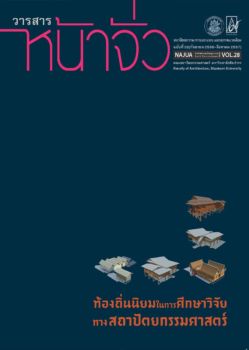เรือนไม้แม่แจ่ม: ลมหายใจของเฮือนบะเก่าล้านนา
Keywords:
แม่แจ่ม, เฮือนบะเก่า, เรือนไม้แบบประเพณีล้านนา, Maechaem, Ancient House, Lanna HouseAbstract
บทความเรื่อง “เรือนไม้แม่แจ่ม: ลมหายใจของเฮือนบะเก่าล้านนา” นี้ เป็นส่วนหนึ่งที่ถอดความออกจากงานวิจัย 2 เรื่องในพื้นที่อำเภอแม่แจ่ม จังหวัดเชียงใหม่ ที่ผู้วิจัยและคณะได้ทำงานวิจัยระหว่าง พ.ศ.2554–2556 มีเนื้อหาเป็นการรายงานการศึกษาผลการสำรวจเรือนไม้แบบ ประเพณีในแม่แจ่ม ประเภท “เฮือนบะเก่า” ซึ่งเป็นรูปแบบเรือนแบบประเพณีของล้านนา ทั้งตัวเรือน และองค์ประกอบของบ้าน เพื่อเปรียบเทียบกับเรือนแบบประเพณีล้านนาในพื้นที่อื่นๆ และเอกสาร ตำราที่ได้ศึกษาก่อนการลงพื้นที่ผลการศึกษา พบว่า เรือนไม้แบบประเพณีในแม่แจ่มยังคงหลงเหลืออยู่อย่างหนาแน่นใน พื้นที่เล็กๆของโหล่งแม่แจ่ม แม้จะพบว่าเรือนเหล่านี้กำลังลดจำนวนลง ส่วนใหญ่เป็นเรือนแบบ “เฮือนบะเก่า” ทั้งแบบจั่วแฝดสองจ๋อง และแบบจั่วเดี่ยวจ๋องเดียวเป็นเรือนไม้สักที่สวยงามมีเอกลักษณ์เฉพาะพื้นที่ ทำให้เรือนมีความโดดเด่นควรค่าแก่การศึกษาเก็บข้อมูลเพื่อการอนุรักษ์ต่อไป เรือนส่วนใหญ่อยู่ในสภาพแวดล้อมแบบพื้นถิ่นล้านนาที่ดี มีองค์ประกอบตามแบบประเพณีเป็นส่วนใหญ่ ส่วนหนึ่งเป็นเพราะวิถีชีวิตของพ่ออุ๊ยแม่อุ๊ยชาวแม่แจ่มยังคงมีความเป็นอยู่แบบเรียบง่ายสมถะ ผูกพันกับวัดและสิ่งศักดิ์สิทธิ์ที่เคารพนับถือในบ้าน ในชุมชน รักษาขนบธรรมเนียม พิธีกรรมต่างๆ ไว้ได้อย่างน่าชื่นชม ทำให้เรือนเหล่านี้ยังคงถูกใช้สอยตามวิถีทางเดิมอย่างที่เคยเป็นมาค่อนข้างมากเปรียบเสมือนเรือนยังมีลมหายใจ อย่างไรก็ตาม สถานการณ์บางอย่างเกิดขึ้นในบางส่วนที่ทำให้น่าเป็นห่วงว่าลมหายใจกำลังแผ่วเบาลง และอาจจะหมดไปพร้อมกับพ่ออุ๊ย แม่อุ๊ยผู้สูงอายุเหล่านั้น ทั้ง การเสื่อมโทรมตามธรรมชาติโดยผู้เป็นเจ้าของไม่มีกำลังจะรักษาไว้แม้มีใจต้องการ ทั้งการไร้ผู้สืบทอด และรสนิยมของลูกหลานที่เปลี่ยนไปตามวิถีชีวิตใหม่
Mae Chaem Wooden Houses: Breath of Lanna Ancient Houses
Suebpong Chansuebsri, Lecturer
Faculty of Art and Architecture
Rajamankala University of Technology Lanna
This article “Mae Chaem Wooden Houses, Breath of Lanna Ancient Houses” is based on two studies in Mae Chaem District, Chiang Mai Province in which the researcher and team became involved in 2011-2013. The content is that of a report on the survey of the traditional wooden houses in Mae Chaem, which was classified as “Ancient Houses” of the Lanna style based on the main part of the house and other elements in order to compare them with other Lanna houses in other areas. Some of the information was drawn from other documents and textbooks surveyed before going into the field work.
The study results showed that a cluster of Mae Chaem traditional wooden houses was left in a small area of the district called “Long Maechaem” and the number of houses could become fewer and fewer in the near future. Most of the houses were of the ancient Lanna style of either twin-gable roof or single gable roof. They were beautiful teakwood houses that were unique and worthy of studying and conserving. Most of the houses were in a good local Lanna environment and were mostly of the traditional elements. Part of this was due to the simple lifestyle of the old people of Mae Chaem whose life was closely related to the temples and the sacred objects they respected which made them continue the customs and rituals very admirably well and caused these houses to continue to be used and function as usual. This made it feel like the houses were still breathing although some situations made it seem like the breathing was becoming weaker and weaker and could be expiring with those older people along with the natural deterioration, which made the owners unable to preserve them as they wished, that along with their lacking inheritors and the change in the taste of the younger generation due to their new lifestyle.





